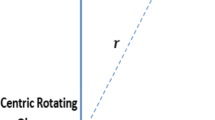Abstract
When space-reflection and time-reversal symmetries are broken, the Thomas precession formulas derived by Thomas' method and from the BMT equation differ from each other. This apparent contradiction is resolved by pointing out that the breakdown of discrete symmetries may lead to a change in the operational meaning of the Lorentz-group elements.
Similar content being viewed by others
References
J. Bailey,J. Phys. G4, 345 (1978).
V. Bargmann, L. Michel, and V. L. Telegdi,Phys. Rev. Lett. 2, 435 (1959).
S. I. Rubinow and J. B. Keller,Phys. Rev. 131, 2789 (1963).
J. D. Jackson,Classical Electrodynamics, 2nd edn. (Wiley, New York, 1975), pp. 556–559, 541–547.
Author information
Authors and Affiliations
Rights and permissions
About this article
Cite this article
Balog, J., Hraskó, P. Thomas precession and the operational meaning of the Lorentz-group elements. Found Phys 11, 873–880 (1981). https://doi.org/10.1007/BF00727104
Received:
Issue Date:
DOI: https://doi.org/10.1007/BF00727104




